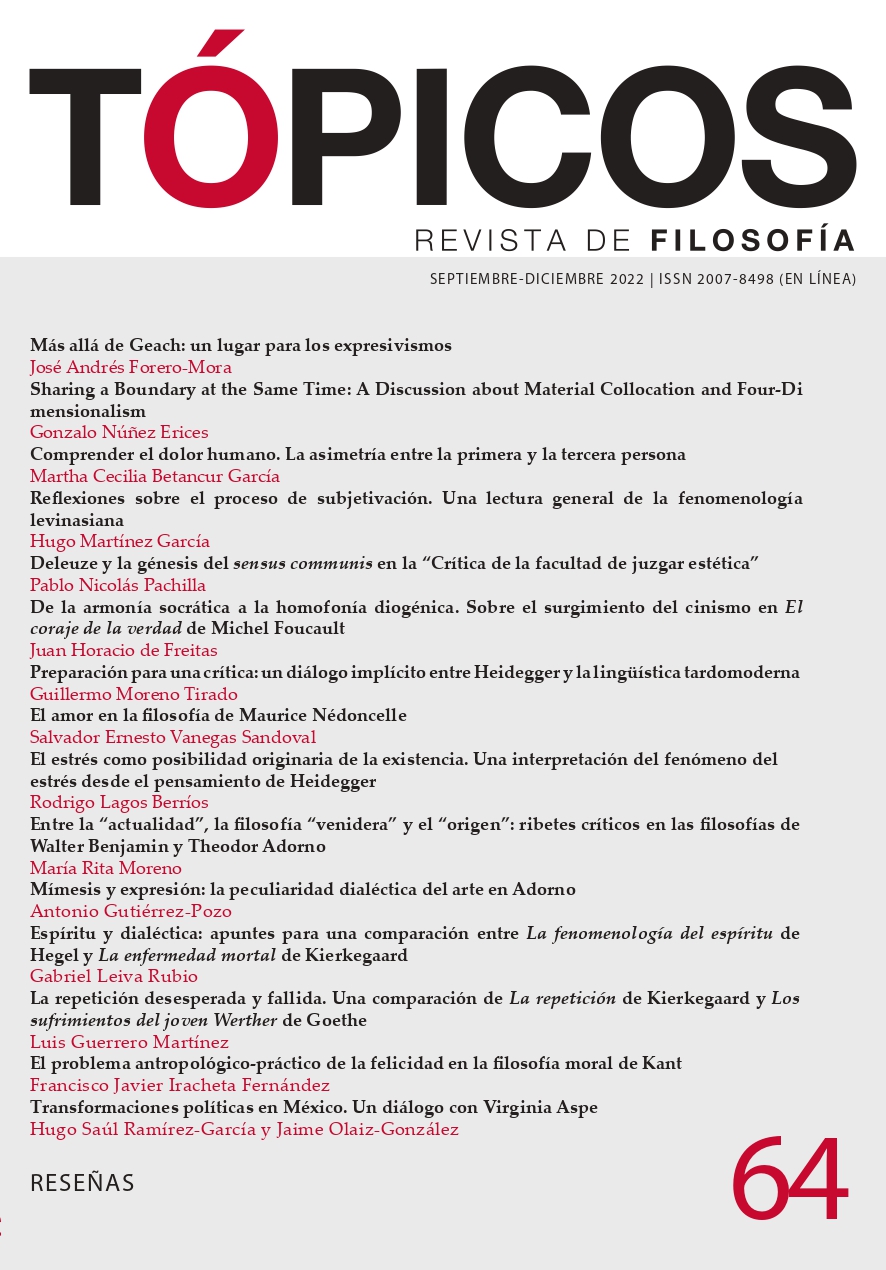Compartiendo un límite al mismo tiempo: una discusión sobre colocación material y el tetradimensionalismo
Publicado 2022-08-13
Palabras clave
- límites,
- objetos materiales,
- colocación,
- persistencia,
- perdurantismo
- endurantismo ...Más
Derechos de autor 2022 Tópicos, Revista de Filosofía

Esta obra está bajo una licencia internacional Creative Commons Atribución-NoComercial-SinDerivadas 4.0.
Cómo citar
Resumen
¿Es posible para dos objetos materiales compartir un solo límite? La colocación material es una tesis metafísica según la cual dos objetos cualitativamente diferentes comparten el mismo límite de una región espacial y, por ende, se componen de la misma materia a pesar de diferir en algunos aspectos metafísicos (por ejemplo, propiedades temporales y/o modales). Este artículo aborda las implicaciones metafísicas de la colocación en relación con una tesis sobre límites y persistencia temporal. Se plantea una discusión sobre endurantismo y perdurantismo: mientras el primero entiende los objetos físicos como entidades con límites en las tres dimensiones espaciales, el último los entiende como entidades que poseen límites en cuatro dimensiones, considerando el tiempo como una más. Finalmente, el artículo preesnta dos críticas al perdurantismo: una respecto del compromiso de Mark Heller con el esencialismo de límites en objetos tetradimensionales; la otra, con el argumento de la analogía entre límites espaciales y temporales.
Referencias
- Bennett, K. (2004). Spatio-Temporal Coincidence and Grounding Problem. Philosophical Studies: An International Journal for Philosophy in the Analytic Tradition, 118(3), 339-371.
- Brentano, F. (1981). The Theory of Categories. R. M. Chisholm and N. Guterman (trans.). Martinus Nijhoff.
- Brentano, F. (1988). Philosophical Investigations on Space, Time and the Continuum. B. Smith (trans). Routdlege.
- Burke, M. (1992). Copper, Statue and Pieces of Copper: A Challenge to the Standard Account. Analysis, 52(1), 12-17.
- Burke, M. (1994). Preserving the Principle of One Object to a Place: A Novel Account of the Relations Among Objects, Sorts, Sortals, and Persistence Conditions. Philosophical and Phenomenological Research, 54(3), 591-624.
- Cartwright, R. (1975). Scattered Objects. In K. Lehrer (ed.), Analysis and Metaphysics. (pp. 153-175). Reidel.
- Doepke, F. (1997). Spatially Coinciding Objects. In M. Rea, Material Constitution: A Reader (pp. 10-24). Rowman & Littlefield Publishers.
- Hacker, P. M. (1982). Events and Objects in Space and Time. Mind, 91(361), 1-19.
- Haslanger, S. (1989). Endurance and Temporary Intrinsics. Analysis, 49(3), 119-125.
- Hawley, K. (2001). How Things Persist. Clarendon Press.
- Heller, M. (2008). The Ontology of Physical Objects. Cambridge University Press.
- Hinchliff, M. (2006). The Puzzle of Change. In S. Haslanger and R. Kurtz (eds.), Persistence: Contemporary Readings. (pp. 287-305). MIT Press.
- Hirsh, E. (1982). The Concept of Identity. Oxford University Press.
- Johnston, M. (2006). Is There a Problem about Persistence? In S. Haslanger and R. Kurtz (eds.), Persistence: Contemporary Readings. (pp. 241-284). MIT Press.
- Jubien, M. (1993). Ontology, Modality, and the Fallacy of Reference. Cambridge University Press.
- Koslicki, K. (2008). The Structure of Objects. Oxford University Press.
- Lewis, D. (1986). On the Plurality of Worlds. Blackwell.
- Lewis, D. (2006). Tensing the Copula. In S. Haslanger and R. Kurtz (eds.), Persistence: Contemporary Readings. (pp. 429-441). MIT Press.
- Locke, J. (2008). An Essay Concerning Human Understanding. Oxford University Press.
- Lowe, E. J. (1987). Lewis on Perdurance versus Endurance. Analysis, 47(3), 152-154.
- Lowe, E. J. (2002). A Survey of Metaphysics. Oxford University Press.
- McGrath, M. (2007). Four-Dimensionalism and the Puzzle of Coincidence. In D. Zimmerman (ed.), Oxford Studies in Metaphysics. Volume 3. (pp. 143-176). Oxford University Press.
- Moyer, M. (2009). Does Four-Dimensionalism Explain Coincidence? Australian Journal of Philosophy, 87(3), 479-488.
- Olson, E. (2001). Material Coincidence and the Indiscernibility Problem. The Philosophical Quarterly, 51(204), 337-355.
- Olson, E. (2002). The Ontology of Material Objects. Philosophical Books, 43(4), 292-299.
- Olson, E. (2007). What are we? A Study in Personal Identity. Oxford University Press.
- Olson, E. (2008). The Paradox of Increase. In P. van Inwagen and D. Zimmerman (eds.), Metaphysics: The Big Questions. (pp. 390-417). Blackwell.
- Quine, W. V. (1960). Word and Object. MIT Press.
- Rudder, L. (1997). Why Constitution is not Identity? The Journal of Philosophy, 94(12), 599-621.
- Schaffer, J. (2009). Spacetime the One Substance. Philosophical Studies: An International Journal for Philosophy in the Analytic Tradition, 145(1), 131-148.
- Shorter, J. M. (1977). On Coinciding in Space and Time. Philosophy, 52(202), 399-408.
- Sider, T. (2001). Four-Dimensionalism: An Ontology of Persistence and Time. Clarendon Press.
- Sider, T. (2006). Four-Dimensionalism. In S. Haslanger and R. Kurtz (eds.), Persistence: Contemporary Readings. (pp. 197-231). MIT Press.
- Sider, T. (2008). Temporal Parts. In T. Sider, J. Hawthorne and D. Zimmerman (eds.), Contemporary Debates in Metaphysics. (pp. 241-262). Blackwell.
- Simons, P. (1985). Coincidence of Things of a Kind. Mind, 94(373), 70-75.
- Simons, P. (1987). Parts: An Study in Ontology. Oxford University Press.
- Skow, B. (2007). Are Shapes Intrinsic? Philosophical Studies, 133, 111–130.
- Stroll, A. (1988). Surfaces. University of Minnesota Press.
- Taylor, R. (2006). Spatial and Temporal Analogies and the Concept of Identity. In S. Haslanger and R. Kurtz (eds.), Persistence: Contemporary Readings. (pp. 35-49). MIT Press.
- Thomasson, A. L. (2007). Ordinary Objects. Oxford University Press.
- Van Inwagen, P. (2001). Ontology, Identity and Modality. Cambridge University Press.
- Wasserman, R. (2018). Material Constitution. The Standford Encyclopedia of Philosophy. E Zalta (ed.). URL: https://plato.stanford.edu/archives/fall2018/entries/material-constitution/.
- Wiggins, D. (1968). On Being in the Same Place at the Same Time. The Philosophical Review, 77(1), 90-95.
- Wiggins, D. (1980). Sameness and Substance. Blackwell.
- Yagisawa, T. (2010). Worlds and Individuals: Possible and Otherwise. Oxford University Press.





